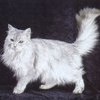|
Somali Cat
Because of the unique appearance Somali Cat, they have been nicknamed Fox Cats or Feline Fox. Somalis have a striking, bushy tail and a ruddy coat.
In addition to the fluffy tail, the Somali breed features a black stripe down its back, large ears, a lovely full ruff and breeches, contributing further to the overall "foxy" look.
The fox like Somali, also known as the Longhaired Abyssinian, is a breed of cat that is famous for its distinctive look, superior intelligence and playful, loving, personality.
Abyssinians and Somalis share the same personality (active, intelligent, playful, curious) and appearance. The difference between the breeds is the fur length and therefore the amount of grooming required.
Unlike most long-haired cats, Somalis shed very little excess hair. Their coat is generally shed en masse or "blown", once or twice a year, rather than constantly shedding like a Persian or other cats of long hair. Their coat is a soft, fine, dense double coat. They have tufts of fur between their toes.
The Somali cat does not tolerate cold temperatures well, despite their dense, longhair coat. Somali Appearance and Colors
Their coats are ticked, which is a variation on tabby markings, meaning that each hair has bands of color. The coloring of the coat can be ruddy, fawn, red or blue. They may have white coloring on the upper throat or nostril and chin area. White elsewhere on their bodies disqualifies them from show-status.
Some Somalis may show full tabby stripes on portions of their bodies, but this is seen as a flaw. Tabby Somalis are only sold as neutered pets. The only tabby marking on a show Somali is the traditional tabby 'M' on the middle of the forehead.
Like Abyssinians, they have a dark rim around their eyes making them look like they are wearing kohl.
Somali Personality
Somali cats are known for their alertness and energy. The Somali cat has bursts of energy frequently throughout the day. They may run around the house during these energy bursts. They may run sideways like a monkey. They are playful and may hide inside cupboards. Plenty of toys, attention, company and a cat gym are all that is needed to keep the Somali happy.
Most adept at using their paws like hands, they have been known to turn on faucets and play with the water. The Somali cat may hold food between its front paws. It enjoys human companionship. They frequently attempt to communicate with humans with soft meowing. As they are so eager to interact with humans, they are recognized as being wonderful companion pets.
Although the Somali is an active breed, they make very good indoor cats. They are best as an indoor, housecat as their agenda-driven lifestyle does not allow for good road sense. Indoor life helps to protect local bird population also.
The Somali cat has a muscular body. This cat breed is slow to mature. It reaches full size at about eighteen months of age. Eyes may be green or amber, the richer color the better.
History
How they came to be is unknown. As the story goes, it is believed that they came into existance when the Abyssinian population was decimated after World War II and new blood was introduced into the Abyssinian line.
The Somali breed has existed since the 1950s, but they were not recognized as a separate breed until the late 1970s. In the late 1970s, the Somali was fully accepted in North America, then in the 1980s they were accepted in Europe. By 1991 the breed was accepted worldwide.
From information researched, it seems the longhairs have been appearing in Abyssinian litters for many years. From the 1960s onward several dedicated breeders in Australia, USA and England worked to attain full recognition and acceptance of the semi-longhaired cousin of the Abyssinian.
The Somali is now accepted in registries worldwide. Breed Standards (the description of the ideal breed specimen) closely resemble the Abyssinians aside from the coat length. Somali Cat Photos
|





